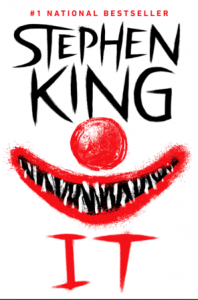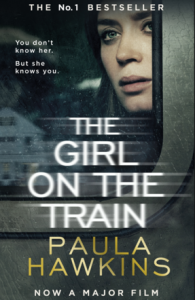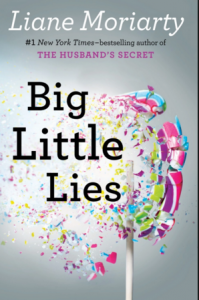Shame, Shame, We Know Your Name—Or Do We? Shame & Fiction
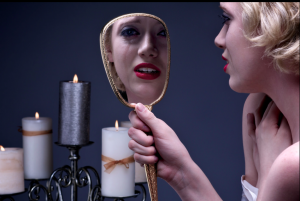 Image via Flickr Creative Commons, courtesy of DualD Flip Flop
Image via Flickr Creative Commons, courtesy of DualD Flip FlopRecently, I wrote a guest post This is the Reason All Great Stories are Birthed from Shame. It was a tough post and I needed a nap after writing it. It forced me to peel back layers I hadn’t touched in years. But the post got me thinking about probably the single most important element of great fiction
SHAME.
Since that post was not per se a craft post, I wanted to explore what I began on that blog here today. I firmly believe shame is the critical ingredient for fiction to resonate. It’s the difference between a forgettable fun read and a book we keep and read over and over.
Some Examples
I dig examples. I learn better when I have some to work with, so sharing some goodies with you today.
It by Stephen King
It is, of course, terrifying and is the main reason a disproportionate number of Gen Xers hate/fear clowns. But what makes the story so great is SHAME. Big Bill (protagonist) made the paper boat for his little brother, the paper boat that was then was swept into a gutter, the gutter where the beast was waiting to devour an unsuspecting six-year-old (thus kicking off the story).
Bill also has a terrible stutter. He is ashamed of his stutter and suffers false guilt for the death of his little brother Georgie.
The Losers Club
All the characters in this novel suffer from profound shame, especially Bill’s allies (who call themselves The Losers Club). Ben is morbidly obese and his mom a single parent in the 1950s. Beverly’s father beats her and is sexually inappropriate with her. Stan lives under the cloud of being a Jew, and Mike is black. They face shame in regards to who they are in the WASP dominated world of post WWII America. Richie is socially awkward and tries too hard. Eddy is a hypochondriac, ashamed of his perceived (yet false) delicate constitution.
Without shame, this story would be uninteresting and forgettable because the real monsters in this book are not (only) what is lurking beneath Derry (though that sucker is pretty terrifying), rather what is in each of the children then later adults that also must be defeated—their shame. The monsters who look a lot a hell of a lot like people.
The Girl on the Train by Paula Hawkins
The protagonist is a raging alcoholic propelled by real and false shame. She is ashamed (obviously) that she is a drunk, but she’s also ashamed her drinking supposedly ruined her “once perfect” life. Yet, once she is pulled into a potential murder mystery, she uncovers not everything is as it seems and in seeking truth, she also uncovers the seeds of her shame were not planted by her.
Big Little Lies by Liane Moriarty
Three protagonists drawn together over a seemingly innocent infraction in a Kindergarten…that ends in murder. All three protagonists are propelled by shame.
Madeline was abandoned by her first husband, who now has decided to move practically next door.
Celeste has a perfect life that is a perfect lie. Because she is perfect, who can she turn to with the truth?
Jane is an outsider and mother of an illegitimate son, fathered by a man whose real name she doesn’t even know.
The Ones We KEEP
When I think of all my favorite characters? The ones I remember and keep in my heart forever, why do I love them? Their shame. Harry Bosch is ashamed that he was the son of a murdered prostitute, that she was thrown away by the system. Everyone matters or no one matters.
Mickey Haller (The Lincoln Lawyer) is ashamed his father never loved him, that he never measured up. He’s ashamed he failed an innocent client who’s serving life in prison because that was the only way Mickey could save him from the needle.
The Hobbits are ashamed they are too little to make a BIG difference.
Shadow in (American Gods) is ashamed of going to prison, believes he’s culpable for his wife’s death.
Y’all get the gist.
Finding the Shame
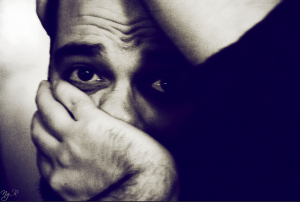 Image via Flickr Creative Commons, courtesy of Noemi Galera.
Image via Flickr Creative Commons, courtesy of Noemi Galera.Some of us older folks recall that schoolyard taunt, “Shame, shame we know your name!” But I think this nasty taunt can serve as an interesting guidepost when crafting visceral and dimensional characters. When we begin with our story idea, I feel it’s imperative to look for, find and NAME the shame.
When we start out? No, shame, shame we DO NOT know your name.
But we need to.
Shame is a powerful driver of character decisions and actions. It’s the linchpin for all the emotional armor, the lock on the box of the inner demons. The story problem is the crucible for exposing then firing away the shame. That is how we know the protagonist has evolved to a hero. We can’t accurately determine any character’s Goal, Conflict ,or Motivation until we know the dark place they’re doing everything to protect.
Finding the shame can elevate an okay story to an unforgettable one.
A Good Example
 Image via Flickr Creative Commons courtesy of Alan Levine
Image via Flickr Creative Commons courtesy of Alan LevineFor instance, last week I had a student of the log-line class call me for a consult. She had an interesting story but it was all falling flat for a reason she couldn’t quite grasp. I liked her idea, but sensed she was right. Something important was missing.
Her story was set in the 70s and a young girl was running away from home because of her alcoholic mother. Girl jumps out of the frying pan and into the fire, so to speak when she runs away and gets tangled in a world of predators (sex, drugs and rock and roll). Yet, what happened was the story just was a series of bad situations.
Running away is not a story goal. It’s passive and stories need active goals. Protagonists can run away but heroes return to face and conquer. So how could this protagonist return and when she did, what exactly would she face and conquer?
Her story idea lacked the connective tissue it needed to fully come together.
In this case, the connective tissue was…
You got it. SHAME.
I asked the writer, “Okay so WHY does the mother drink? WHY is she an alcoholic?” Because an answer of, “Well it’s genetics” or “She just likes Jameson way too much” isn’t meaty enough for a good fiction.
I challenged her to think about why the mother drank. What was HER shame that she was numbing with booze?
The writer actually hadn’t asked that critical question, btw.
Since the story is set in the 70s, women were very vulnerable. Mom has four kids. She wouldn’t be able to get a bank account without her husband’s permission. Odds were she had no money of her own and no way to get it without her husband’s knowledge. Divorce was highly frowned on and if she did get a divorce the courts likely would have ruled in the man’s favor.
So why does Mom drink? *puts on thinking cap*
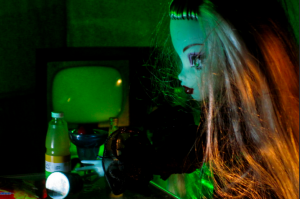 Image via Flickr Creative Commons courtesy of davidd
Image via Flickr Creative Commons courtesy of daviddWhat if the father the protagonist (the teen) adores who everyone thinks is this super amazing guy is actually an abusive bastard? What if he’s a traveling salesman who takes great joy in coming home and relaying his conquests to his wife? Tells her if she hadn’t let herself go pumping out babies, he wouldn’t need to find other women?
He’s a narcissist, manipulator and master of gas-lighting everyone, including his kids. Mom drinks because she is ashamed she is so powerless. She is ashamed she married such a person, that she believed he loved her. She probably also has false shame from his abuse (she is fat, ugly, stupid, useless).
So you have a scene. Mom comes out into living room ready to go to a cocktail party. Dad makes a big deal over how beautiful she looks in front of the kids, goes up and passionately kisses her (oh the adoring husband) then whispers “lovingly” in her ear, “Don’t you have a tighter girdle? I’ve seen pigs with a better figure.”
Mom’s face changes and she mutters something about needing to adjust her girdle and twenty minutes later stumbles out clearly toasted. Dad then sighs to the kids and gives the pained Look at what I have to put up with face.
So in the beginning, the teen protagonist is unaware of the real villain (because of incidents like the one above). She’s judgmental of Mom, but when she runs away, she gets a hard dose of reality and matures. She begins to see things in a new light, her mother in a new light.
NOW, the antagonist (alcoholism) can be defeated because when she returns she can forgive her mother and even possibly expose her father. Lay shame at the feet of the person who should be held accountable for it. Once she helps free Mom of false shame, Mom can get help for her drinking.
By naming the shame, we’ve taken a story of vignettes and threaded something entirely new throughout that holds the story together in a far deeper way. The writer was pleased, I was pleased and I think she has a hell of a story that I look forward to reading.
Why Do We Miss This?
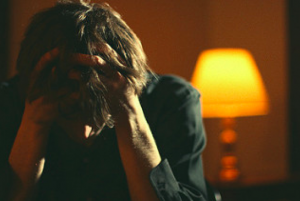 Image courtesy of Eflon via Flickr Creative Commons
Image courtesy of Eflon via Flickr Creative CommonsWhen I get samples from writers, I see a lot of uber-perfect Mary Sue characters. Heck, my first novel? My protagonist was beautiful, a genius, always made good decisions and she bored the paint off the walls.
I believe a lot of new writers are afraid. I was. Often looking for shame for a character makes us have to dig into our own tender places.
OUCH.
But, it IS worth it. Promise!
So I challenge you to look at your own work and see if you can pinpoint the shame. My stories all sucked until I learned this. Finally, I got brave.
In my debut novel, The Devil’s Dance, Romi’s shame is she grew up trailer trash and is from a highly dysfunctional family. Her mother abandoned her as a kid and every man who’s ever loved her has betrayed her. Every decision she’s made has been to escape her shame—leaving the trailer park, going to college, landing the perfect job and perfect guy.
But what happens when everything she’s carefully constructed comes tumbling down on her head, dumping her right back in the one place she vowed to never return to?
She did everything to escape the trailer park and now it’s her only refuge.
She’s forced into a position to face the shame that has been driving her. Romi has a LOT of baggage and baggage makes for interesting characters and stories ( click the sidebar and get a copy 

